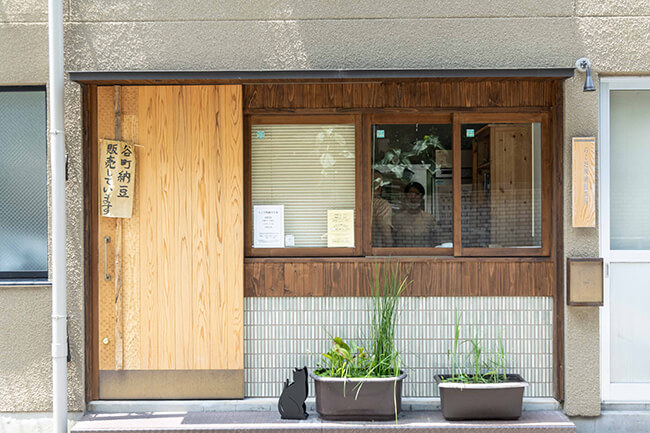Craft Natto from Osaka: Premium Fermentation in Every Bite
Jan 16,2025
Craft Natto from Osaka: Premium Fermentation in Every Bite
Jan 16,2025


Most people recognize that natto [fermented soybeans] is rich in nutrients and helps regulate the gut microbiome. And lots of people incorporate natto into their daily diet for health and beauty reasons. Still, there are those who dislike natto because of its smell and particular taste.
Entering into this conversation is Tanimachi Natto from Rakudazaka Natto Kobo, which is getting rave reviews for its delicious taste of soybean’s sweetness and umami richness. We spoke to Rakudazaka Natto Kobo’s owner, Idogawa Koichi, about his natto-making passion and his insistence on using domestic soybeans and natural natto bacteria found in rice straw.
Rakudazaka Natto Kobo is located on a corner in a residential district of Tanimachi, once home to Osaka Castle’s noblemen. Founded in May 2021, it is the only natto atelier in Osaka’s city limits. Idogawa Koichi, the owner, previously operated a popular izakaya pub called Umazake Kamunabi that specialized in Japanese saké for over a decade.
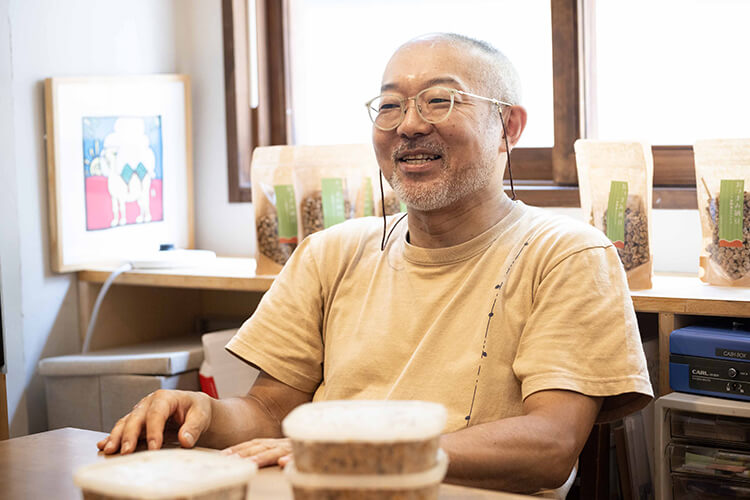
Owner Idogawa Koichi, his wife, and two staff members run the atelier
“We were trying our hand at a number of fermented food products, but it was a comment by the actor Shiga Kotaro, who was a regular customer at the pub, that started us down the path of making natto. He said: ‘Natto is easy to make as long as you have soybeans and straw.’ The process itself is simple, but what attracted me is how delicious it turns out to be. I’ve been making it now for over 20 years.”
Dishes using Idogawa’s homemade natto became the pub’s signature items. Encouraged by customers, who said things like “I don’t like natto; the only one I can eat is Kamunabi’s natto” and “I wish you would sell Kamunabi’s natto”, Idogawa set up the natto atelier.
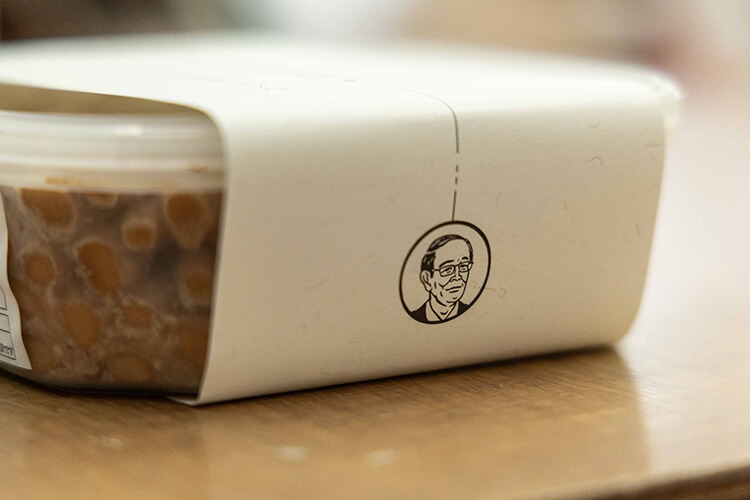
The packaging features an illustration of the late actor Shiga Kotaro, which has become a symbol of the atelier
Rakudazaka Natto Kobo’s Tanimachi Natto, which is making believers out of even those who hate natto, is made with very specific ingredients. To start, cultivated natto bacteria is not used; instead, the natto is fermented with natural natto bacteria found in rice straw. And not any rice straw, but a particular variety of pesticide-free straw from Harada Farm, an organic farm in Nose, Osaka.
“When you use natural natto bacteria, the fermentation process moves more slowly than with cultivated natto bacteria. Our natto takes twice as long to ferment than ordinary natto. But because it continues to ferment gradually even after it’s finished, our natto keeps longer and is less likely to develop an ammonia smell or a crunchy texture. Furthermore, because the soybean proteins and other components are not broken down all at once, the soybean’s umami and sweetness are still present when you eat the natto, which why I think people find it so delicious.”

The rice straw is cut to uniform lengths. Idogawa currently has the rice straw processed at a neighborhood community workshop.
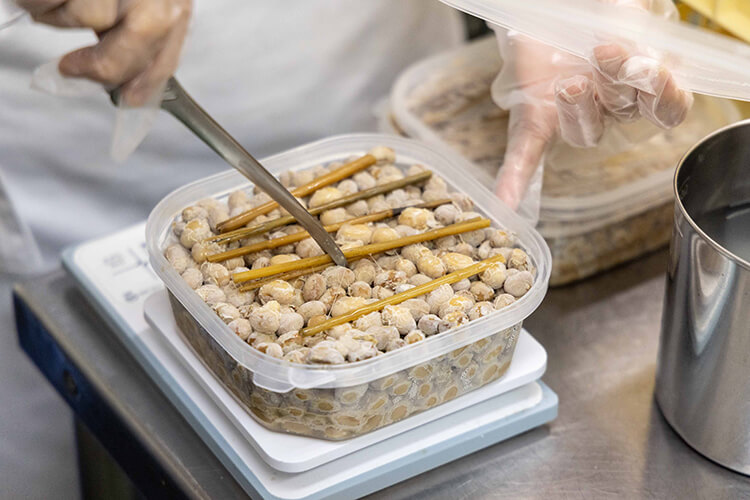
Boiled rice straw is placed in a container. Even when the straw is removed to eat, the natto will continue to mature because the natto bacteria gets evenly distributed throughout the container.
Idogawa uses domestic soybeans from known producers. Rather than the small-grained soybeans or ground soybeans that have been selectively bred for natto, he chooses large-grained soybeans cultivated for tofu that have plenty of sweetness and umami. Currently, he mainly uses a variety called toyomadoka grown at the Tatsumi Farm in Kamikawa, Hokkaido. Another distinction of Tanimachi Natto is how the soybeans are steamed until they are as soft as possible, which may be the secret to its great taste.

An employee checks to see whether the fermentation is progressing properly. The process requires a lot of manual work and only 600 packages can be produced a week.
“I think that the way we soften the soybeans brings out their umami. Moreover, natural natto bacteria are not as powerful as cultivated natto bacteria, so if the soybean skins were hard, it would be difficult for the bacteria to penetrate the beans. Natto made by large producers is harder because they use filling machines to package the natto. If it were soft, it wouldn’t pass through the machines. We, on the other hand, don’t divide our natto into small portions, but instead hand-pack it into 500-gram plastic containers.”
Because of its softness, Tanimachi Natto is loved by everyone, from babies who can eat baby food to older people. When fresh, it has little of natto’s characteristic smell and stringy stickiness, and you can fully appreciate the umami of the soybeans. The fermentation continues over time, and it develops more of the particular flavor of natto. One of the attractions of Tanimachi Natto, then, is the enjoyment of its tasty evolution.
Tanimachi Natto does not come with any sauce or spices, to better enjoy the pure flavor of natto. Idogawa recommends that you first try it without any seasonings or condiments. After taking a bite, sprinkle on a little salt to bring out more of the umami of the soybeans.
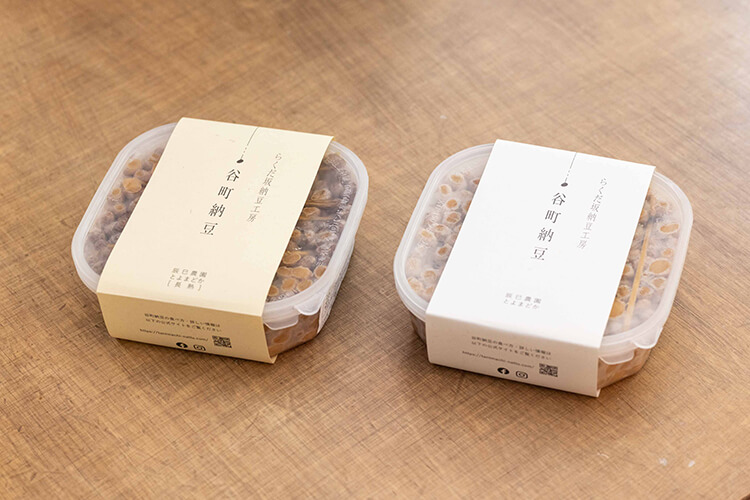
There are two standard variations. Tanimachi Natto (right) has a mild flavor that retains the soybeans’ umami. Choujuku Natto (left) is fermented 1.5 times longer than Tanimachi Natto and is recommended to people who prefer strong, complex flavors.
When the natto has matured and the flavor has gotten stronger, try it with other seasonings, mix it with avocado or kimchi, or use it in stir-fries and other dishes. And certainly try having it in your favorite way too.
“Seasoning it with sugar and soy sauce — something many people do in Aomori and Hokkaido — makes it salty-sweet and very delicious too. If you pair natto seasoned with sugar and soy sauce with rice cake, it feels like you are eating mitarashi dango [rice flour dumplings covered with a sweet soy sauce glaze]. I recommend trying natto soup too. Having natto on rice is a relatively new practice that dates back to the late Edo period (1603 to 1868), whereas natto soup is the traditional way to eat natto. It was even served at the tea ceremonies of Sen no Rikyu [a Japanese tea master]. The standard way to make natto soup is to boil vegetables and deep-fried tofu in hot water, and when they’re thoroughly cooked, add mashed natto and miso to turn it into miso soup.”
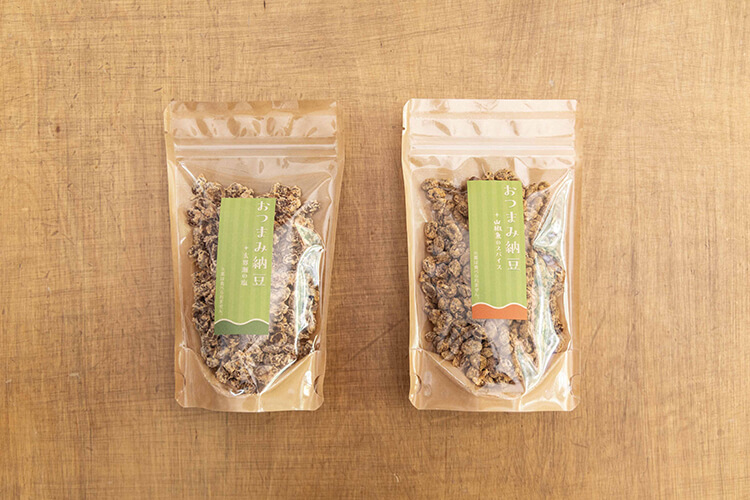
Dried natto snacks made with Tanimachi Natto (salted and spicy variations). The flavors go perfectly with a drink, and they make great souvenirs that can be kept at room temperature.

This limited-edition salted & spicy natto product consists of Tanimachi Natto fermented and aged with rice koji malt and salt. Idogawa recommends serving it as an accompaniment to rice or eating it with cucumbers.
Rakudazaka Natto Kobo products are available for purchase at the atelier itself and on their online store. If you purchase products at the atelier and bring back the container for reuse, a discount is given. Idogawa is seeing more and more regular customers arrive with containers in hand. The atelier’s natto is becoming a part of the lives of people in the neighborhood.
“We want to be a neighborhood natto shop. Compared to the past, there are fewer and fewer small natto makers in business today. I’d like to see more people do what we are doing and establish natto shops in each area, much like the natto vendors in the early Showa period (1926 to 1989).”
